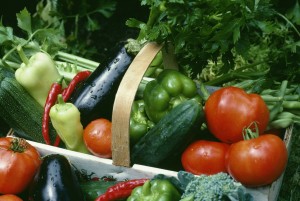The term “slow food” has rapidly hit the nation as being a hot, new, and sustainable trend. “Slow Food” is defined as eating and supporting food from local sources that are also environmentally friendly. The concept behind slow food encourages people to learn how to enjoy food that supports the local community and the environment. So how can we get local and seasonal food throughout the nations? Check out these ideas:
- Find your local Slow Food chapter by visiting the Slow Food website.
- Learn where your local farmers markets are located and shop there for your produce. Simply type in your zip code and find a farmers market near you. They are all over the country!
- Remember: focus on color of various fruits and vegetables. Each week try to eat a variety of colors by including a fruit or vegetable from every color of the rainbow. Have you had your red, orange, yellow, green, blue, purple, or white this week? While shopping at the farmers markets, you can even ask the farmer how to cook or eat the produce.
- Remember: fruits and vegetables contain phytochemicals, which are important substances that plants naturally produce to protect themselves against viruses, bacteria, and fungi. These substances, such as carotenoids, flavonoids, and isoflavones, are known to promote bone health, vision health, brain health, and cardiovascular health. Also, these colorful fruits and veggies contain antioxidants which help to protect the body from cancer, cardiovascular disease, diabetes, and many other diseases when we ingest them.
Seasonal Suggestions: Use this guide to buy the fruits and vegetables in the season they are grown. Buying seasonal can also reduce cost and the produce is at its freshest point!
Spring- March, April May
Apricots (beginning of May) Artichokes Asparagus Avocados Basil Beets Boysenberries/Blackberries/Blueberries (beginning of May) Broccoli Cabbage Carrots Cauliflower Celery Cherries (beginning of May) Chinese Cabbage Cucumbers Fava beans Grapefruit Green Garlic Greens: Kale and Collards Iceberg Lettuce Kiwi Mangoes Okra Spring Onions Oranges Papayas Peaches (beginning of May) Peas Chile Peppers Sweet Peppers Radishes Rhubarb Shallots Spinach Spring Salad Mixes Strawberries (beginning of May) Summer Squash Turnips Watermelon (beginning of May) Zucchini (beginning of May)
Summer- June, July, August
Avocados, Hass Apples (beginning mid-July) Apricots Basil Beets Boysenberries/Blackberries/Blueberries Cantaloupe Cherries Corn (beginning end of June to end of September) Cucumbers Dates Eggplant Figs Garlic Grapes (beginning mid-July) Green Beans Mangoes Melons Nectarines (beginning end of May) Limes Okra (beginning mid-July to mid-September) Olallieberries Onions Oranges, Valencia (beginning mid-July) Peaches Peas Pears (beginning mid-August) Chile Peppers Sweet Peppers Pineapples Plums Potatoes Strawberries Summer Squash
Fall- September, October, November
Acorn Squash Almonds Apples Artichokes Basil Broccoli Brussels Sprouts Butternut Squash Cabbage Chinese Cabbage Carrots Cauliflower Celery Root Chestnuts Chicory Cranberries Cucumbers Dates Eggplant Endive Fennel Grapes Greens Iceberg Lettuce Leaf Lettuce Leeks Mushrooms Nuts Okra Mandarin Oranges Naval Oranges Parsnips Pears Chile Peppers Sweet Peppers Persimmons Pistachios Pomegranates Quince Shallots Spinach Winter Squash Star Fruit Sweet Potatoes Swiss Chard Tangerines Tomatoes Turnips Walnuts Yams
Winter - December, January, February
Artichokes (beginning in February) Avocados Bok Choy Broccoli Brussels Sprouts Cabbage Chinese Cabbage Carrots Cauliflower Celery Root Chicory Fennel Grapefruit Greens: Kale and Collards Green Onion Kiwi Kumquats Leeks Lemons Wild Mushrooms Mustard Mandarin Oranges Sweet Oranges Parsley Parsnips Pears Quince Rhubarb, hothouse Spinach Winter Squashes Sweet Potatoes Turnips Walnut
? Sarah Koszyk, MA, RD, is a nutrition coach at Eating Free who cooks with love and loves to eat.







